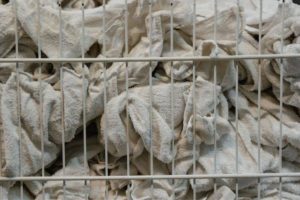Quick Navigation
As an Airbnb host, one of the most important aspects of providing guests with a memorable and enjoyable experience is ensuring that the sheets and towels provided are clean and stain-free.

However, from time to time, guests may accidentally leave stains on sheets and towels during their stay. It can cause frustration for the host and the guest, and it’s important to know what to do in these situations.
This article will provide practical advice and tips for preventing and handling stains on sheets and towels. Also, information on reimbursement options for damaged items.
How to Handle Stains on Sheets and Towels
Handling stains on sheets and towels can be challenging for Airbnb hosts. But taking quick and effective action can help minimize damage and ensure that they are usable for future guests.
Here are some steps that hosts can follow when handling stains:
Quick Response
The sooner you act, the better your chance of removing the stain. If you become aware of a stain, address it as quickly as possible.
It will prevent it from setting in and becoming more challenging to remove. To help guests with this, consider providing a stain remover. For them to use if they are the ones to remove the stains.
Determine the Stain Type
Determining the type of stain is essential in removing it effectively. Different stains respond to different removal techniques and products.
Some common types of stains include:
- Oil-based stains: These include food, makeup, and grease stains.
- Protein-based stains include blood, sweat, and food like eggs or milk.
- Tannin stains: These are caused by coffee, tea, red wine, and other beverages containing tannins.
- Dye stains: These are caused by colored liquids like fruit juice, candy, and colored drinks.
- Organic stains: These are caused by organic materials like grass, leaves, and food.
Choosing the Proper Cleaning Method
Different stains necessitate varying cleaning techniques. For example, oil-based stains can be treated with a degreaser. While wine and other beverage stains are removable with white vinegar and water.
Research the best cleaning method for each type of stain and keep various cleaning supplies on hand.
Removing Stains without Damaging the Sheets & Towels
When cleaning stains, it’s essential to be gentle and avoid using harsh chemicals. Or abrasive tools that could damage the fabric.
Follow the cleaning instructions carefully and try the solution on a discreet small portion of the fabric before treating the entire stain.
Blot Gently
Instead of rubbing the stain, gently blot it with a cloth or sponge to lift it off the fabric. It is often more effective than using a rubbing motion.
To blot a stain, place a clean cloth or sponge over the stain. Then press gently to eliminate as much of the stain as feasible.
Do not scrub or rub the stain, as this can cause the stain to spread or become more difficult to remove.
Blotting is most effective when the stain is still fresh and hasn’t had time to set into the fabric. The faster you address the stain, the better your chances of eradicating it using this gentle blotting method.
Use Cold Water

Using cold water is often a recommended step in removing stains from fabric. The cold water helps to prevent the stain from setting into the fabric, making it easier to remove.
In most cases, it’s more effective than hot or warm water for removing stains.
When using cold water to remove a stain, blot it with a clean sponge or cloth to remove as much of it as possible.
Then, run cold water over the stained area, using your fingers to rub the fabric together to remove the stain gently.
Repeat the stain removal process until the stain is no longer visible or has faded as much as possible.
It’s important to note that some stains, such as oil-based or protein-based stains, may require hot water to remove them effectively.
Always check stain removal guides and charts to determine the best water temperature for extracting a particular type of stain.
Test First
Before trying a new product or method for removing stains, test it on a small, inconspicuous area of the fabric. It will ensure it doesn’t cause any adverse effects.
To spot test, apply a small amount of the product or solution to a hidden area of the fabric. Allow it to sit for a few minutes.
Then, check the area for any color or texture changes and ensure it hasn’t caused any damage.
If the spot test shows no adverse effects, you can use the product or method on the stained area.
Wait to Dry until the Stain Is Gone
Delay the drying process until the stain has been completely removed. The heat from the dryer can cause the stain to set in permanently.
So try multiple stain-removal methods before putting the fabric in the dryer.
If the stain is particularly stubborn or cannot be removed, it may be necessary to replace the affected item.
Prevention of Stains on Sheets and Towels
Prevention of stains on sheets and towels is an essential part of maintaining a successful Airbnb rental.
There are several steps that hosts can take to reduce the stains and keep their sheets and towels looking best:
- Clear communication with guests: Providing clear instructions on how to care for the linens and towels can help prevent accidental spills and stains. It can include information on how to properly use and clean the items and guidelines for their usage during the stay.
- Providing additional linens and towels: Providing extra linens and towels for guests can encourage them to switch to a fresh set if they spill or stain the first set, reducing the chances of permanent damage to the items.
- Invest in high-quality sheets and towels: Choosing durable and high-quality linens and towels can reduce the likelihood of stains and help prolong the items’ life.
- Regular washing and cleaning: Regular washing and cleaning of the linens and towels can keep them looking their best and reduce the chance of stains.
Reimbursement for Damaged Sheets and Towels

Reimbursement for damaged sheets is an essential issue for Airbnb hosts. It can help to offset the costs of replacing items that have been damaged or stained beyond repair by guests.
There are several options for reimbursement, including:
Airbnb’s Host Guarantee: Airbnb offers a Host Guarantee, which protects up to $1,000,000 for damage to the host’s property caused by guests. It includes damage to linens, towels, and other items in the rental.
Security deposit: Many Airbnb hosts require guests to pay a security deposit upon check-in or booking. The deposit will cover the damages, including stained or damaged linens and towels.
Guest reimbursement: If a specific guest caused the damage, you could request a refund from the guest directly.
You can send an invoice or bill for the replacement items or negotiate a mutually agreed-upon amount.
Host insurance: Some hosts opt to purchase host insurance which provides additional coverage for damages caused by guests, including stains on linens and towels.
In some cases, reimbursement for damaged linens may not be possible, especially if the item is relatively inexpensive.
However, by clearly understanding your options and being proactive in seeking reimbursement, you can help minimize the impact of stained or damaged linens and towels on your Airbnb business.
Conclusion
Stains on sheets and towels can be a common problem for Airbnb hosts.
Taking steps to prevent stains, handle them effectively when they occur and seek reimbursement for damages can help minimize their impact.
Investing in high-quality sheets and towels, communicating clearly with guests, and being diligent in your cleaning and maintenance efforts can help provide guests with a comfortable and enjoyable experience.
It also maintains the overall health and success of your Airbnb rental. We hope that the information we provide helps you handle stains on sheets and towels.
So you’ll always have a satisfied guest on your Airbnb rental.






